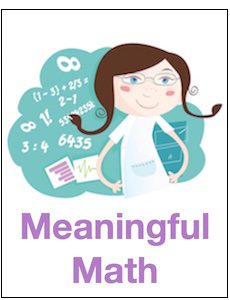When the Math Anxiety Shifts to Math Boredom
A MiddleWeb Blog

But lately instead of students talking about being anxious, I’m hearing a lot students talk about how boring math is.
It usually goes like this, “…no offense, Mrs. Russell, but math is so boring.” Usually they say this after I tell them how much fun we are about to have in math. Of course this is not the first time I have heard this, but I’m hearing it a lot this year.
How can anyone think math is boring? I talked with my family about it, and they agreed with my students that math is indeed boring.They really, really agreed.
They said the reason I don’t find it boring is because I’ve always been good at it. That’s not true. If I am good at it now, it’s because I thought it was interesting and kept going until I figured it out.
In fact, I would say I’m of average math ability at best. I remember studying “slope” for days until it clicked with me what it really meant. I understood the formula but couldn’t get the concept. But I enjoyed thinking about it, and puzzling over it. When I finally understood, it felt great.
It really bothers me that my students think math is so dull. I don’t want them to leave my math class with that opinion. I feel like part of my mission is showing my classes how wonderful and fun math can be. If they think math’s boring I need to do a better job showing them it’s not.
Why Students Think Math Is Boring

Then there’s the fact that whether something is boring or interesting is very subjective. What some students find interesting others will find boring. There’s not time to personally tailor lessons for individual students.
What Can I Do to Make Math Interesting?
Here’s what I see when we as math teachers try to make math “fun.” We give students a few math problems and then let them do “fun” activities, like a scavenger hunt etc. Nothing wrong with that. I do it all the time.
But that’s not letting students see that math is fun: the scavenger hunt is the fun part, math is still the boring part. Same thing with the bingo and Jeopardy games I played with my students. I want them to see that the math IS the fun. I want them to enjoy working on the problems, struggling with problems, and then figuring them out.
Below are a few strategies and activities I’ve been using in my effort to fight the boredom:
► Whiteboards
Watching someone do math is not fun, but doing math yourself can be. There are times when direct instruction is needed, but lately I’ve been making an effort to put the math in my students’ hands as quickly as possible.
Whiteboards are very helpful in this regard. Students can quickly do math, and just as quickly erase mistakes. They can hold up their boards and get feedback, and I can see what they know. This year I taught multiplying binomials exclusively with whiteboards, and the students really liked it. A few even said that multiplying binomials was, yes, fun.
► Let the Students Be the Teacher
I have certain students who love to go in front of the class and be the teacher. I will assign them a problem to present to the class, and they will work it out on the SmartBoard and teach it to their peers. They enjoy explaining how to work the problem, and the other students enjoy learning from them.
► Let Students Create Their Own Data
I also teach AP Statistics, and I am finding that students love to create their own data. This “my data” idea can carry over into other math courses and grade levels.
It is much more fun and interesting to students if they can use data they create. This year I have had them time their heartbeats for one minute and check how long they could stand on one leg with their eyes closed (read about the Blind Stork Test here).
They have also tossed thumb tacks and tried to tell the difference between Coke and Pepsi in a blind taste test. No matter how simple the activity is, students are more engaged when they are collecting and examining their own data.
► Don’t Stop Learning
It can be close to impossible for me to find time to learn something new related to math or to research new teaching strategies. But when I do find the time, it definitely pays off. Some of my colleagues recently went to a math convention and came back and shared the new things they learned, and I really felt excited about trying those ideas out in my classroom.
Looking Ahead
If you have activities or ideas about how to make math more intrinsically interesting for students, please share in the comments. Below I’ve listed some other resources I think might be useful. Some of them I have used in my classroom and some I haven’t tried “live” yet.
I needed the reminder from my students that not everyone thinks math is interesting. I plan to do better in the future to share my enthusiasm for math and explain why I am enthusiastic. It helps them and me!
Resources



































I think you hit the nail on the head with the word “intrinsic”. When teaching is driven by a fixed curriculum that you the teacher have to race through, it is also extrinsic motivation — someone else dictates what you shall learn. The key I’ve found to getting kids excited about math is to let them choose which math interests them, by giving them a range of games and puzzles, and letting them choose what interests them. (see my math game initiative http://mathmonday.net) It’s similar to letting kids choose their own books in reading class. And give them math that is intrinsically interesting, not just instructional exercises. The intrinsically interesting math includes puzzles and games, art and movement activities, and stories and biographies. My 9th grade geometry teacher gave his students choice by asking every student to give a brief report on a math topic of their own choosing every quarter — that was the first and only time I was given real choice in a math class, and I chose to invent my own math puzzles and games. Since then I’ve often led puzzle design sessions with students of all ages, asking them to invent their own mathematical puzzles, then publish a book of their creations. What amazes me is that the kids all know immediately what they want to do and who they want to do it with…it’s as if they were just waiting for someone to give them permission to let loose.